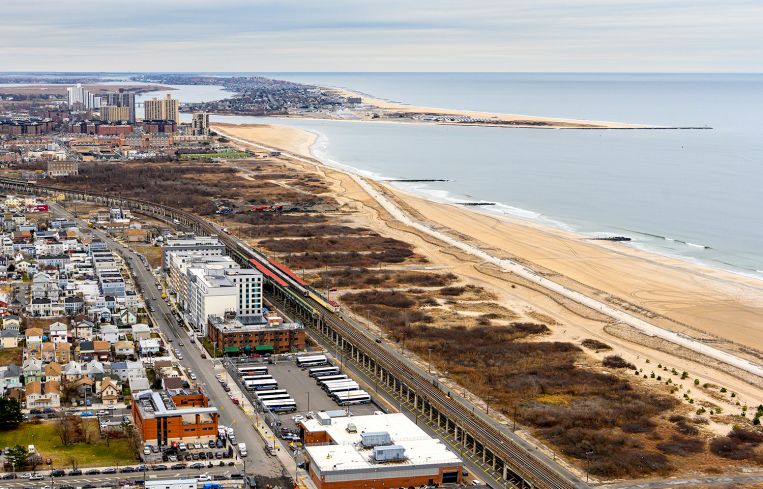City Council Subcommittee Scraps Vote on Queens Affordable Housing Project
Local council member’s concerns delay decision on the planned Rockaway development as residents call for market-rate housing instead
By Aaron Short August 2, 2023 5:06 pm
reprints
City leaders have enabled the development of tens of thousands of apartments on the Rockaway Peninsula over the past two decades, but one Queens council member has had enough.
A New York City Council zoning subcommittee scrapped its vote Tuesday on a planned 106-unit project in Bayswater, Queens, because Councilmember Selvena Brooks-Powers wanted significantly more long-term homeownership opportunities and more parking spaces in the plan.
The proposal, known as the Ocean Crest project, seemed like a longshot from the start. Its developers, the Massachusetts-based nonprofit The Community Builders, wanted to upzone a lot on 29-32 Beach Channel Drive to build an eight-story complex with community space on the ground floor and 27 parking spaces. Households earning between 30 and 80 percent of the area’s median income, or $38,000 to $102,000 per year, would be eligible to rent one of the units.
But the project encountered opposition from the Bayswater Civic Association, which said the building was too tall for the surrounding area, and Queens Community Board 14 members, who said the neighborhood’s infrastructure had not been substantially upgraded to absorb an increase in the area’s population.
That hasn’t stopped the city from directing dozens of affordable housing projects to the 11-mile-long peninsula before this.
Since the city rezoned 280 blocks of the Rockaway peninsula between Rockaway Beach and Far Rockaway in 2008, tens of thousands of new homes have been built. Even the devastation that Hurricane Sandy wrought in 2012 hasn’t deterred developers. Large-scale affordable housing projects, including Arverne by the Sea, Arverne East and Edgemere Commons, have brought thousands of new residents to Southeast Queens from other parts of the city.
In 2017, then-Mayor Bill de Blasio advanced another rezoning in downtown Far Rockaway with the promise of $288 million in investments in new green space, school facility upgrades, and spruced-up commercial corridors. As many as 10,000 new homes will be built on the western edge of the peninsula in the next three years.
But longtime residents have grown wary of the city’s plans and community board members believe the city is unfairly concentrating low-income housing in their neighborhoods.
“We have disapproved of a number of projects because we’re worried about overpopulation but the city keeps on building stuff here,” John Gaska, district manager for Community Board 14, said. “We have more vacant land and land is cheaper, so money could be made doing affordable and low-income housing but we’d much rather see market-rate housing.”
Board members ultimately voted against the Crest Project plan in March, citing concerns about the lack of green space, playgrounds, and parking, as well as the building’s height, while stating a preference for one- and two-family homes to be included in future rezoning plans.
“We want to purchase things, we want to own things, especially those who’ve been here for years. We’re tired of renting,” Sonia Mosie, a Community Board 14 member, told the Rockaway Wave.
The community board’s opinion, while advisory, remains influential among elected officials. Councilmember Brooks-Powers asked for the project to include more residential units available for ownership and more parking spaces while expressing reservations that too many units have been concentrated in Far Rockaway, according to a Crain’s New York Business report. A spokesperson for Brooks-Powers did not return a call for comment.
The City Council has not rescheduled its vote that was originally set for Tuesday, and it remains unclear whether the developers will submit a new plan or abandon the proposal entirely. Spokespeople for The Community Builders did not return requests for comment.
The stalemate showed how challenging it can be to approve new housing projects in the city. Council Speaker Adrienne Adams has not been inclined to override the opposition of local members on zoning matters, instead preferring to give them space to negotiate with developers for more community benefits such as lower area median income levels.
That strategy worked to pass controversial projects in the East Bronx and Long Island City, Queens, and may eventually lead to a different plan in Far Rockaway. But it may have tanked an affordable residential project in Harlem (which may be resurrected after Yusef Salaam won the Democratic primary this summer for the council seat for the neighborhood.)
Despite the Rockaway project’s vote being stalled, Queens Borough President Donovan Richards wants the Council to allow more development as the city continues to grapple with a housing shortage and rising homelessness.
“We must move with the urgency of now and build our way out of these crises by rapidly expanding our affordable housing stock and growing home ownership opportunities in Queens, especially in historically disadvantaged communities like the ones in Rockaway,” he said in a statement.


